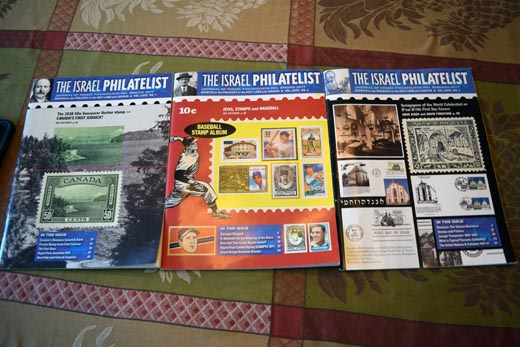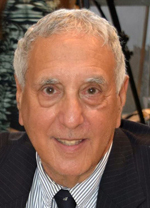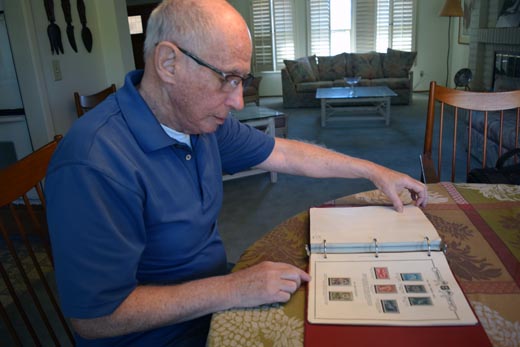
By Donald H. Harrison

EL CAJON, California – We can thank a Sunday school teacher in Buffalo, New York, for the fact that Donald Chafetz of El Cajon is one of the best-known authorities in the United States on stamps and postal covers of Israel and environs.
Chafetz, editor of The Israel Philatelist, an authoritative quarterly publication, recalled in an interview that he was a student in Sunday school at Temple Beth El in Buffalo, New York, in 1948, the year of Israel’s independence. The school’s director, Marvin Garfinkel, regularly received new issues of Israeli stamps which he resold to synagogue members and their children.
“He was a big Judaica collector and an Israel (stamp) collector,” Chafetz recalled. “In Sunday school, we would all go into his office and look at the stamps he had available for us to purchase. He was a little bit like a dealer.”
What was it about the Israeli stamps, and U.S. stamps too, that attracted Chafetz?
“I like stories,” he responded. “I liked to read the stories behind the stamps. Every stamp tells a story. There is a reason for it.”
“Also, I liked the art work that goes into it,” Chafetz continued. “When you consider that a stamp is a miniature piece of art, to be able to tell a story either with an individual stamp or a series of stamps takes talent, so I appreciate their ability to tell the story with stamps. And, then, I like to do the research about the story behind the stamps.”

Between the time he was a school boy buying stamps in Buffalo and a semi-retired electrical engineer living in the San Diego suburb of El Cajon, Chafetz had a career and family to build.
Upon his graduation in 1962 from the United States Military Academy, West Point, Chafetz married Betty, whom he had met in his freshman year at the University of Buffalo. They had met in Buffalo at an AEPi pledge party after he learned of his acceptance at West Point, and she told him that like him, she would be transferring to New York to study at a nearby Teacher’s School in New Paltz. They dated during his four years at West Point and her time at the teacher’s school, where she earned a degree in art history education.
Soon the Army sent the couple to Munich, Germany, where Chafetz, promoted to captain, was in charge of logistics at a headquarters company for units patrolling near Germany’s border with Austria. Daughter Gwyn, who today works for a health services company in Los Angeles, was born in Munich in 1965. Son Ross, today a physical therapist in Philadelphia, was born in 1968 in Dover, New Jersey
Following his four-year tour in the Army, Chafetz went to Purdue University, where he obtained a master’s degree in electrical engineering, and thereafter worked for 18 years for Exxon Research and Engineering, based in Florham Park, New Jersey. His job involved setting up computer systems to control various processes at Exxon refineries. He and Betty spent between six months and a year in such countries as Holland, Germany, Norway, Venezuela, and the Canary Islands.
The computers were built in Phoenix, Arizona, by General Electric, requiring him to spend considerable time there. His old mentor, Marvin Garfinkel, was then living in nearby Sun City and the two men reconnected.
It wasn’t until both of his children were out of college, however, that Chafetz returned seriously to his boyhood passion of stamp collecting. He wrote articles for Linn’s Stamp News as well as for the New Jersey Postal History Society, which focuses stamps and postal covers relating to New Jersey. He later decided to pursue a master’s degree in business administration at the University of Chicago.
One day while he and Betty were driving along Lake Shore Drive, their car stalled and died, forcing them to slog back to their Chicago apartment in a blizzard. He remembers their turning to each other and asking, ‘What are we doing here?’ Daughter Gwyn was living in Southern California, while Betty’s brother and late sister-in-law, Chuck and Susan Hayman were then residing in San Diego County. “California here we come!” was the Chafetzes’ decision.
Chafetz was contacted by the president of the Society of Israel Philatelists, asking him if he would like to become the editor of The Israel Philatelist, to which he had contributed various articles. He hesitated at first, wondering if dyslexia might make the job of editing too difficult. Against Betty’s “better advice,” he decided to take the position in 2003.
Initially, the quarterly magazine would send stories to a printer, which would return galleys to him, which he then in turn would paste up, and send back to the printer. Long having been computer literate, Chafetz considered this procedure a waste of time and energy, so he laid the magazine out on a computer. Subsequently, he turned the publication from one utilizing black and white photographs to one displaying stamps and covers in full color.
A typical issue, printed on 8 ½ inches by 11 inches, high glossy paper stock, runs about 60 pages, and, says Chafetz, “In the journal, the stamp or the cover are the main objects, but it is the stories behind them that makes it really interesting.”
Feature stories are written not only about stamps from Israel, but those issued in the “Holy Land,” which includes stamps from Turkish Palestine, British Mandate Palestine, and the environs. Stamps and postmarked envelopes issued by Israel and its Arab adversaries in the various wars since David Ben-Gurion declared independence in 1948 also are covered.
Additionally, the journal delves into such postal history topics as the Holocaust, Jewish baseball players, synagogues around the world, and famous Jews.
Chafetz has served as the United States Commissioner at two regional and one international stamp exhibition in Israel–a job which entails gathering collections from American philatelists, escorting them to Israel, setting them up for display, and then safely returning them to their owners. In such capacity, he said, he has been responsible for “ several very interesting Holy Land and Judaica collections.”
“If anybody is interested in history and likes to read, philately offers tremendous opportunities,” Chafetz said. “In the journal, I like to tell interesting stories. … What is important about Holy Land philately is that we Jews are not that numerous in the world. A very small percentage of the world is Jewish. We have a rich history and we’ve had people who have made really significant contributions to the world. Through philately, I am trying to keep alive stories of the traditions, the people.”
“Even if you don’t collect stamps, I think it is important to support the effort of Israel philatelists, and learn stories about Judaism that you might not find anywhere else,” Chafetz continued. “Stamps and covers tell stories that you might not read anywhere else.”
More information about The Israel Philatelist can be accessed on line at www.israelstamps.com.
*
Harrison is editor of San Diego Jewish World. He may be contacted via donald.harrison@sdjewishworld.com